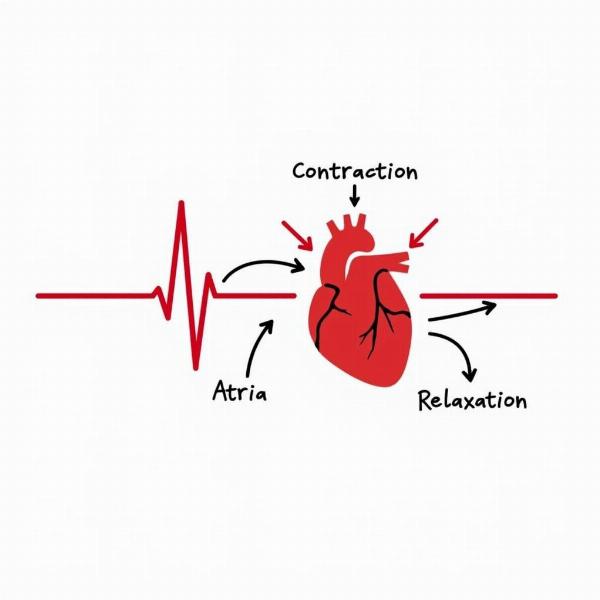Cardiac pulsation, the rhythmic throbbing we feel in our chest and wrists, is a fundamental sign of life. Understanding what it means, both in English and Hindi, can help us better appreciate our health and recognize potential issues. But what exactly does “cardiac pulsation” mean in Hindi? This article will explore the meaning, significance, and various aspects of cardiac pulsation, providing you with a comprehensive understanding of this vital bodily function.
What is Cardiac Pulsation?
Cardiac pulsation, simply put, is the heartbeat. Each pulsation represents one cycle of the heart contracting and relaxing, pushing blood throughout our body. It’s the driving force behind our circulatory system, delivering oxygen and nutrients to our tissues and removing waste products. This rhythmic beat is a vital indicator of our cardiovascular health.
 Diagram of Cardiac Pulsation
Diagram of Cardiac Pulsation
Cardiac Pulsation Meaning in Hindi: हृदय स्पंदन (Hriday Spandan)
In Hindi, cardiac pulsation is referred to as “हृदय स्पंदन” (Hriday Spandan). “हृदय” (Hriday) means heart, and “स्पंदन” (Spandan) means pulsation or throbbing. So, “Hriday Spandan” literally translates to “heart pulsation” or “heartbeat.” Understanding this term can be particularly helpful when communicating with healthcare professionals or discussing health matters with Hindi-speaking individuals.
Why is Understanding Cardiac Pulsation Important?
Monitoring your heart rate can provide crucial insights into your overall health. Changes in heart rate, rhythm, or strength can signal underlying medical conditions. Knowing what a normal heart rate feels like can help you identify irregularities and seek timely medical attention if necessary.
Factors Affecting Cardiac Pulsation
Several factors can influence your heart rate. These include:
- Physical Activity: Exercise increases heart rate to meet the body’s increased demand for oxygen.
- Stress and Anxiety: Emotional stress can trigger the release of hormones that elevate heart rate.
- Medications: Certain medications can affect heart rate, either increasing or decreasing it.
- Underlying Medical Conditions: Conditions like heart disease, thyroid problems, and infections can impact heart rate.
Measuring Your Cardiac Pulsation
You can easily measure your heart rate by checking your pulse. Common pulse points include the wrist (radial artery) and the neck (carotid artery). Simply count the number of beats you feel in one minute. Smartwatches and fitness trackers also offer convenient heart rate monitoring features.
When to Seek Medical Attention
While some fluctuations in heart rate are normal, certain changes warrant medical attention. Consult a doctor if you experience:
- Rapid Heartbeat (Tachycardia): A persistently elevated heart rate even at rest.
- Slow Heartbeat (Bradycardia): An unusually slow heart rate.
- Irregular Heartbeat (Arrhythmia): A heart rhythm that feels uneven or skips beats.
- Chest Pain or Discomfort: Any chest pain or pressure associated with changes in heart rate.
Conclusion
Understanding cardiac pulsation, or “हृदय स्पंदन” (Hriday Spandan) in Hindi, is essential for maintaining good health. By recognizing the factors that influence heart rate and being aware of potential warning signs, you can take proactive steps to protect your cardiovascular well-being. Regular monitoring and timely medical consultation are key to ensuring a healthy and rhythmic heartbeat.
FAQ
- What is a normal resting heart rate? A normal resting heart rate for adults is typically between 60 and 100 beats per minute.
- Can anxiety cause an increased heart rate? Yes, anxiety can trigger the release of stress hormones that elevate heart rate.
- How can I lower my resting heart rate? Regular exercise, stress management techniques, and a healthy diet can help lower your resting heart rate.
- What is the difference between tachycardia and bradycardia? Tachycardia refers to a rapid heart rate, while bradycardia refers to a slow heart rate.
- When should I see a doctor about an irregular heartbeat? Consult a doctor if you experience frequent or persistent irregularities in your heart rhythm.
- What does cardiac pulsation feel like? Cardiac pulsation feels like a rhythmic throbbing or beating sensation, often noticeable in the chest, wrist, or neck.
- Is it normal for my heart rate to increase during exercise? Yes, it’s perfectly normal and healthy for your heart rate to increase during physical activity.
Meaning-Hindi.in is your one-stop solution for all your Hindi translation needs. We offer a wide range of professional translation services, including business and commercial document translation, certified and legal document translation, technical and user manual translation, website and localization translation, educational and academic document translation, express translation, and specialized translation. Our team of expert Hindi linguists ensures accurate and culturally sensitive translations, catering to diverse clientele across various industries. For any translation inquiries, feel free to reach out to us. Email: [email protected], Phone: +91 11-4502-7584. Connect with Meaning-Hindi.in today for seamless and reliable Hindi translation services!